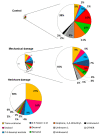Population-Specific Plant-To-Plant Signaling in Wild Lima Bean
- PMID: 36145728
- PMCID: PMC9503452
- DOI: 10.3390/plants11182320
Population-Specific Plant-To-Plant Signaling in Wild Lima Bean
Abstract
The exposure to volatiles from damaged plants can increase the resistance of the neighboring plants to herbivores. Studies have demonstrated that the strength of this response depends on the level of relatedness between the interacting plants. Indeed, a field study with Phaseolus lunatus found that the responses to induced volatiles were population-specific; individuals exposed to damaged conspecifics from the 'local' population exhibited greater resistance to herbivores than those exposed to damaged conspecifics from 'foreign' populations. Here, we repeated this study in the laboratory by placing undamaged plants near damaged plants from either their local or a foreign population. The former plants experienced less herbivory than the latter after a subsequent challenge by a generalist herbivore. To understand the role of the volatiles underlying this observed specificity, we explored the variability in the constitutively released volatiles and volatiles released after mechanical or herbivore damage among the three tested populations of P. lunatus. The total volatile emissions were 5× and 10× higher from the mechanically and herbivore-damaged plants, respectively, compared to the undamaged plants. The populations differed in their relative ratios of dominant constitutive compounds, but no pattern was observed that could explain the differential responses to induced volatiles among the populations. Overall, this study confirms the population-specific volatile-mediated interactions in P. lunatus.
Keywords: Phaseolus lunatus; herbivore-induced plant volatiles; induced resistance; volatile organic compounds; volatile-mediated interactions.
Conflict of interest statement
The authors declare no conflict of interest.
Figures




References
-
- Callaway R.M. The Detection of Neighbors by Plants. Trends Ecol. Evol. 2002;17:104–105. doi: 10.1016/S0169-5347(01)02438-7. - DOI
-
- Karban R. Plant Sensing and Communication. The University of Chicago Press; Chicago, IL, USA: 2015.
-
- Dudareva N., Negre F., Nagegowda D.A., Orlova I. Plant Volatiles: Recent Advances and Future Perspectives. CRC Crit. Rev. Plant Sci. 2006;25:417–440. doi: 10.1080/07352680600899973. - DOI
Grants and funding
LinkOut - more resources
Full Text Sources

